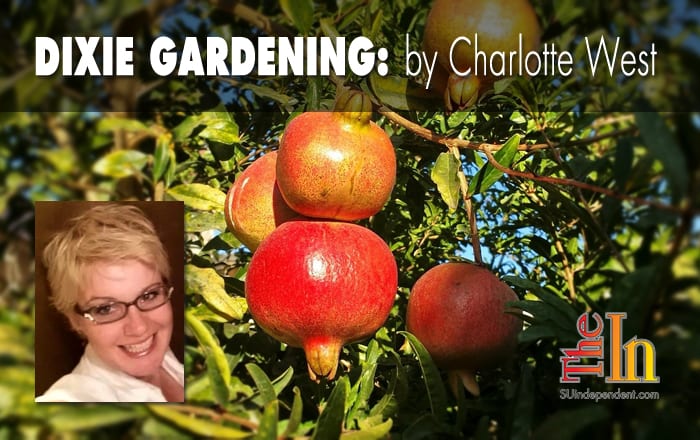
Written by Charlotte West
Naturally, the pomegranate grows 15-20 feet tall and broad but can be pruned back to about 10 feet. It is rather showy in the spring, with its red flowers at the tips of its branches. It yields sweet, tart, juicy fruits, and as an added bonus, it’s self-pollinating.
One of the best known varieties is the “wonderful” pomegranate. Its flowers are an orange-red color and the fruits are a beautiful, burnished red with red pulp. There is also the “sweet” variety, with more of a yellowish flower and pink pulp. And don’t forget the “eversweet,” a virtually seedless fruit with a red pulp that emits a clear, non-staining juice. But around here, folks, the “Utah sweet” is the way to go. It has adapted to be hardy in this area and flourishes quiet well. It is one of the sweetest varieties and has a non-staining, light pink pulp. There are even more varieties, but the ones listed above do well here in Dixie and are some or the tastiest around.
Pomegranates ripen in the fall and should be harvested when they reach full color. If left on the tree for too long, the fruits will split and rot. They can be stored for up to seven months in the refrigerator. You can eat them with ease by cutting the flesh into quarters or eighths and simply pulling back the rind starting from the end, exposing juicy sacs that you can eat, seed and all. If you are going to use the juice to make juice or jams, cut the fruit in half first.
If you live in an area that is too cool, you can plant you tree near a south wall to help. You will be happy to know that pomegranates tolerate a wide variety of soils, even alkaline soils. They are resistant to root fungi and can tolerate considerable drought once established but will produce more with regular watering.
After writing this article, I just might have to run out and purchase myself a pomegranate tree. Hopefully, you just might be inspired to do so as well. Now, I know that it’s the height of summer, so if you do purchase a new pomegranate, baby it, because planting in the heat can be a challenge that’s easily overcome with work.
Subscribe for FREE to get our weekly Sunday Edition email, just signup in the NEWSLETTER box on the right –>




